Archives of Animal & Poultry Sciences - Juniper Publishers
Abstract
Polymorphic variants of few candidate genes have been reported to be associated with production traits in layers. The objective of the present study was to genotype the long term selected pure-line layer population for Growth Hormone Receptor (GHR), Insulin Like Growth Factor -1 (IGF-1) and Prolactin (PRL) hormone gene and to observe their association with layer traits. Layer traits were recorded on 1082 pullets up to the age of 40 weeks under standard management conditions. Genotyping study was performed on 90 randomly selected pullets with reported PCR-RFLP markers for GHR, IGF-1 and PRL genes. The studied population revealed polymorphic pattern for GHR, IGF-1 and monomorphic for PRL. The frequency of Hind III ++ and Pst I ++ genotypes were high in comparison to Hind III - - and Pst I + - genotypes for GHR and IGF-1 gene respectively. Genotype-trait association analysis revealed a trend of association with means of some traits; however, the associations were not significant. The allelic and genotypic frequency of PRL gene at both promoter sites was 1.00 which confirmed the loss of broodiness in studied population. Results of this study indicated that direction of selection has supported the favourable alleles of GHR and IGF-1 genes in the studied layer population
Keywords: Candidate genes PCR−RFLP Egg production GHR; IGF−1 PRL
Introduction
Egg production in chicken is the result of many genes and gene interaction. Rapid understanding of genes and genome of chicken with various molecular markers have opened the opportunity to select for genes that are directly related to egg production traits. Candidate gene approach is one such method to genotype the layer stock for such genes which have significant contribution in genetic variability for egg production. Out of the many identified candidate genes polymorphism in layer chicken, only few have been reported to be significantly associated with egg production or, rate of lay. Most of the genotyping studies for reported SNPs or polymorphisms have largely been carried out with Polymerase Chain Reaction and Restriction Fragment Length Polymorphism (PCR- RFLP) type markers. The Growth Hormone, Growth Hormone Receptor and Insulin Like Growth Factor system (GH-GHR-IGFs) controls the number of follicles in the avian ovary that are recruited to the rapid growth phase [1] and a natural GHR mutation alters the ovulation rate [2]. It is also known that the GH-GHR-IGF-1 system has been modified as a result of selection for improved growth rate and egg production. Polymorphism studies have shown the association between GHR (growth hormone receptor) gene and egg production [3].
The chicken IGF-1(insulin like growth factor) polymorphism in the 5’ region [4] is associated with egg production. [5] reported positive association of ‘A’ allele of IGF-1 genotype with egg production in KNOCK chicken. Chicken prolactin hormone (PRL), a polypeptide, secreted by anterior pituitary is a physiological candidate gene for egg production. [6] reported the polymorphism in chicken prolactin promoter region, which was associated with egg production in different Chinese breeds. Presence of 24 bp indel in the same region was highly associated with egg production and a C/T 2402 SNP was involved in PRL transcriptional output. However, both sites showed monomorphic pattern in WL (white leghorn) chicken. Although, literature supports the association of egg production traits with reported polymorphisms of candidate genes, however, reports are unavailable on significant association of candidate genes with egg number in a long-term selected WL population.
In view of above, screening of existing breeding population for presence/absence of polymorphic variant genotypes for above genes and their association with layer traits is important to study the genetic variability at gene level. The IWH strain of WL hasbeen developed through long term selection programme with major emphasis on annual egg production. However, these stocks have not been analysed for the polymorphic status of reported candidate genes. The present investigation was initiated with the objective to genotype the IWH strain of WL population for GHR, IGF-1 and PRL genes and to analyse their association with egg production.
Material and Methods
Blood collection and DNA isolation
Pedigreed WLH pullets (n=90) were randomly taken from the IWH strain of pure line layers. The strain has undergone 29 generations of family selection [7] for part period and annual egg production in a closed flock at experimental layer farm of CARI, Izatnagar, UP. Performance of pullets for various economic layer traits was recorded up to 40 weeks of age under standard conditions of management. About 0.5-1ml of blood was collected from the jugular vein of each pullet at the age of 10 week by a sterile disposable heparinized syringe. The samples were transported in ice and subsequently stored at -20°C. Genomic DNA was isolated from the blood samples by Phenol: Chloroform extraction method. Quality and quantity of DNA was checked using Nano-Drop Spectrophotometer. The quality of genomic DNA was further checked by submarine agarose gel electrophoresis. Only intact DNA samples, devoid of smearing were utilized for present work
Polymerase chain reaction amplification of candidate genes
PCR primers:One set of reverse and forward primers specific to the gene of interest were used to amplify a region of chicken GHR and IGF-1genes while two sets were used for PRL. The set of primers were synthesized as per the published primer sequences (Table 1).

Setting up of PCR reaction: A total of 25μl reaction mixture was prepared by adding autoclaved triple distilled water 19.7l, 10 X PCR assay buffer (15 mM Mg++) 2.5l (1.5mM), forward and reverse Primer 0.5l (100 ng) each, dNTP mix 0.5l (0.5 mM), Taq DNA polymerase (3U /l ) 0.3 l(1.0 U) and Genomic DNA 1.0l (80-100 ng). The optimized reaction mixture that finally used for amplification for all the three genes was kept same except, the forward and reverse primers. All the above procedures were carried out on ice at 4ºC. Master mixture was mixed properly by vortexing followed by spinning. Finally, 24.0μl of master mixture was added to each PCR tube, containing 1.0μl of genomic DNA, followed by gentle mixing and spinning at 3000 rpm for 5-10 seconds. A negative control labelled ‘C’ containing all reaction components except template DNA was also used to check any contamination of DNA in the reaction components. Finally, the PCR tubes were kept in a pre-programmed thermo cycler (Bio-Rad make) for amplification of desired gene segments as per optimized reaction conditions. PCR products thus obtained were kept at 4ºC for further analysis.
Agarose gel electrophoresis: Horizontal submarine electrophoresis was performed on 2 % agarose gel (7.5μl of PCR product mixed with 1μl of gel loading dye) to check the amplified PCR products. Electrophoresis was conducted at constant voltage of 80 volt for 45 minutes at 37˚C using 1X TBE buffer. The mass ruler DNA ladder (100 bp) was used for size estimation of the DNA bands. The DNA fragments were stained with ethidium bromide and photographed using an ultraviolet (UV) trans-illuminator (BioRad, Gel Doc system) to visualize the bands.
Restriction Enzyme digestion: To identify the Restriction Fragment Length Polymorphism (RFLP), Hind III [8], Pst I [4] and Alu I [6] Restriction Enzymes (RE) were used to detect the polymorphism in GHR, IGF-1 and PRL genes respectively. A 154 bp PCR product was amplified from PRL gene, which was directly observed on 3 % agarose gel for presence or absence of 24 bp indel by horizontal submarine agarose gel electrophoresis. Therefore, restriction enzyme digestion was not needed for this gene. RE digested PCR products were analyzed on 6% PAGE (Poly Acrylamide Gel Electrophoresis) and visualized by silver staining.
Statistical Analysis
Genotypic frequencies of different PCR-RFLP patterns were estimated from the combination of various RFLP alleles generated based on presence or absence of one or more restriction sites. Different genotypes were identified based on different patterns. Gene frequencies were calculated from genotypic frequencies. The allele frequencies were calculated using standard methods [9].The Chi-square (χ2) test for goodness of fit was used to find out difference among various genotypes.
Association of allelic variation with egg production traits in WLH
The effects of IGF-1 and GHR genotypes on least squares means of layer traits were analysed using the GLM procedure (SAS, 6.12). The following model was used:
Yijkl = μ + Gi + Fj + Hk + eijkl
where Yijkl is an observation on the traits, μ is the overall sample population mean, Gi is the fixed effect associated with the ith genotype, Fj is the fixed effect associated with the jth dam , Hk is the fixed effect associated with kth hatch and eijkl is the random error.
Results
In the present investigation PCR-RFLP studies were carried out on some of the candidate genes to study the effects of polymorphism on layer traits in WLH birds. The restriction enzyme digestion of 730-bp product from the intron II of GHR gene revealed GHR-Hind III polymorphism with two types of restriction fragment pattern i.e., 410bp / 320bp for the HindIII (+ / +) genotype and 250bp / 160bp / 320 bp for the HindIII (- / -) genotype respectively (Figure 1). The HindIII++ genotype was at significantly higher frequency (0.966) as compared to HindIII- - (0.033) genotype, which was also true for the HindIII+ and HindIII- alleles in the population studied (Table 2). The 621- bp fragment from 5’-UTR (5’-untranslated region) of IGF-1 gene was restriction digested with PstI enzyme. Single polymorphism at PstI cutting site revealed two different restriction patterns i.e., 257bp and 364 bp for the PstI (+ /+) genotype and 257, 364 and 621 bp for the PstI (+ / -) genotype respectively (Figure 2). The PstI ++ genotype was at significantly higher frequency (0.944) than PstI+ - genotype (0.055). Similarly, frequency of PstI+ allele was significantly higher (0.972) than the frequency of PstI- allele (0.027).
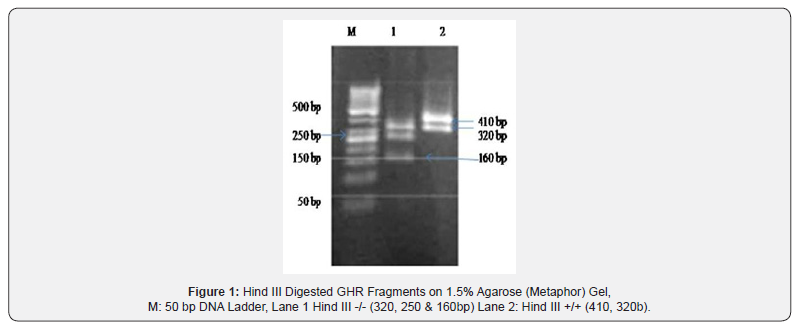
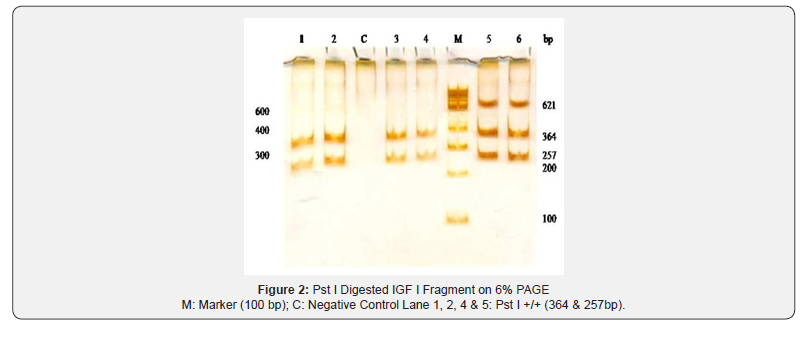
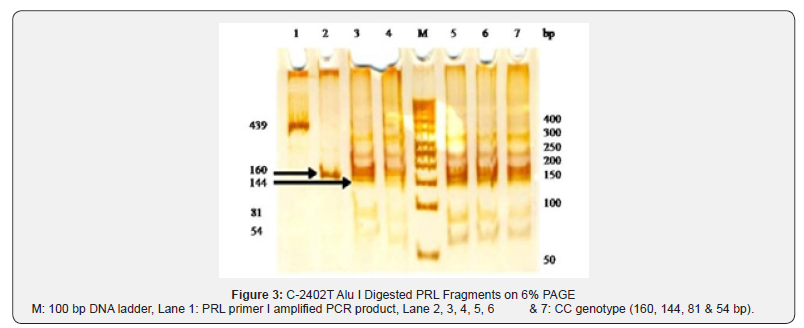
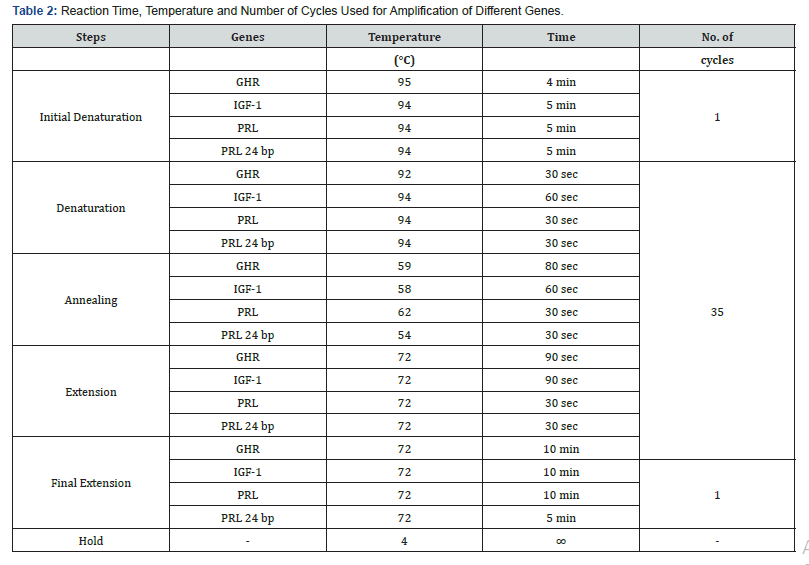
The 439 bp fragment at the promoter region of chicken prolactin gene was amplified by using PRL I primer set. Restriction enzyme digestion of amplified product revealed monomorphic pattern at C- 2402 T site for Alu I enzyme (Figure 3). The fragments observed were of 160 bp, 144 bp, 81bp and 54bp in size. The PCRRFLP pattern revealed presence of CC genotype in the present population, which was like the results of [6] for WLH chickens. The results confirmed the transition of C to T at 2402 bp position as has been reported by [6]. Similarly, insertion of 24 bp at the promoter site -358 of chicken prolactin gene was observed in allthe hens with the second set of primer PRL II. As a result, the PCR product revealed 154 bp fragments on 3 % agarose gel.
Genotype trait association
Associations between genotypes of GHR and IGF-1 genes with layer traits were initially analysed using a linear model that included effects for the GHR genotype, the IGF-genotype, interaction between genotypes of the genes, the effects of dam, effects of sire and hatch. However, the interaction and sire effects were not found significant (P >0.05) on all the traits and were therefore, removed from the model. The effects of polymorphism on layer traits and the least squares means from the two different genotypes of GHR and IGF-1 genes have been presented in (Table 3,4) respectively. The mean values of different layer traits revealed differences among genotypes for both the genes, however no significant associations with genotypes were observed. However, few traits (BW 40, EW 40, EW 28, ASM, MOT 15, MOI 40 and ACL) showed the trend of association with IGF-1 and GHR genotypes at probability value greater than 05 percent but less than 20 percent level of significance.


Discussion
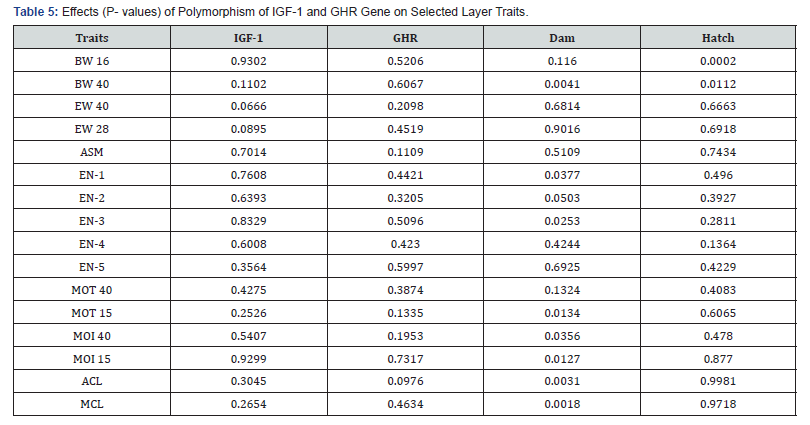
Genotyping studies for the reported polymorphisms in GHR gene have also been conducted by some earlier workers [3,8,10] in different exotic layer populations with the aim to find association of different genotypes with egg production and reproduction traits. The genotypes observed in present investigation for GHR gene were like the findings of [8,10]. GHR Hind III+ genotype was significantly associated with higher juvenile body weight [8] and a trend of association was found with age at first egg (P ≤ 0.14) and housing body weight (P ≤ 0.058). However, no significant association with other layer traits was reported by him. In the present study, similar trend of association with ASM (P≤ 0.11), ACL (P≤ 0.09), MOT 15 (P≤ 0.13) and MOI 40 (P ≤ 0.1935) were observed (Table 3), however the associations were not statistically significant at 5 % or at 1 %. The gene and genotype frequencies reported in present study were comparable to the results of [10] but the frequency of Hind III -/- was lower than the results of [10]. Both have reported comparatively higher frequencies for HindIII + allele as compared to HindIII – allele in their respective population, which has also been observed in the present study. [8] had observed that, there was a tendency for an increase in the frequency of Hind III + allele due to influence of selection (Table 5). Few other reports are available in literature [11,12] for identification of SNP in GHR gene but these SNPs belong to other regions of the gene than the present study.
IGF-1 gene has been reported to be associated with egg production [12] through regulating the growth and differentiation of follicles [13] in layer chickens. Genotyping for associated polymorphism at PstI site have been reported by some workers [4,5] in different exotic layer birds. The observed restriction fragment pattern for PstI + and PstI – allele was similar to the reported literature [4,5,10].

However, PstI - - genotype was not found in present investigation (Table 6). The observed frequency (0.972) for PstI + allele was higher than the frequency (0.83) reported by [4,5] (0.30) in two different layer chickens. [5] reported maximum frequency for PstI - allele in Korean native chicken contrary to the minimum frequency reported by [4] in WLH chickens. In the present study similar trend as reported by [4] was observed for PstI + allele. The allelic and genotypic frequencies for PRL gene at two different promoter sites were 1.00 in the population studied. The results were like the reports of [6] for WLH chicken. Due to monomorphic pattern, association analysis with production traits was not performed for these two genotypes. Presently reported higher frequency of Hind III ++ genotype indicated that direction of selection has supported the favourable allele, however, statistically significant differences were not observed in the least square means of two genotypes. This could have been due to some environmental effects or the background genome would have masked effects of genotypes. Further studies with larger sample size are suggested for the future. Higher frequency of PstI + allele of IGF-1 gene in WLH population has been reported to be significantly associated with egg weight [4]. The average egg weights were higher for the PstI ++ genotype than for PstI - - genotype [4], however; for the same trait, non- significant association was observed by [15].
The results of present investigation were comparable to the results of [4], however no significant association with egg weight was observed. Like the results of [4], a trend of association was observed for EW 28 (P≤ 0.06), EW 40 (P≤ 0.08) and BW 40 (P≤ 0.11) at higher levels of probabilities. [5] reported that Pst I ++ genotype was associated with higher egg production at the age of 50 week than PstI - - genotype. [10] have reported similar results for the association of IGF-1 polymorphism with 300- and 400-days egg production. The results of present investigation differed from the findings of [5,10] regarding absence of PstI - - genotype in the population studied. PstI - - genotype was reported to be associated with low egg production [5,10] and its frequency was reported to be higher in native chickens [5,10] than the WLH chickens. Higher frequency of PstI ++ genotype and the absence of PstI - - genotype in the population studied, indicate that the direction of selection for increased egg production has supported the favourable allele. Further studies with larger sample size, therefore, are suggested for the future.
The monomorphic patterns of PRL gene with both the primers sets confirm the loss of broodiness in the present layer population. The insertion of 24 bp (with primer pair PRL II) indel has been reported to be associated with lack of broodiness. [11] reported that insertion of 24 bp nucleotide sequence in the promoter region may inhibit a transcriptional factor-binding site for PRL and, therefore, decreases the expression of PRL, which contributes to non-broodiness in + / + hens. [6] reported that the frequency for II genotype in WL layers was 1.00 and the marker trait association analysis indicated that the 24 bp indel was associated with egg production (P < 0.01). Similarly, the C-2402 T AluI polymorphism has also been reported to show a frequency of 1.00 in WL population as compared to other native layers [6].
The present result with 1.00 frequencies for both the 24 bp
indel and C-2402 T confirms the reports of previous workers
[6,11] that WL population under selection for egg production has
lost the broodiness character. From the present study, it may be
conferred that direction of selection has stabilized the favourable
alleles of selected gene candidates due to longer generations of
selection [16]. The selected gene candidates would be of more use
to explore the genetic variability in egg production traits of shortterm
selected layer population or, native chicken.
To Know more about Archives of Animal & Poultry Sciences
Click here: https://juniperpublishers.com/index.php





No comments:
Post a Comment